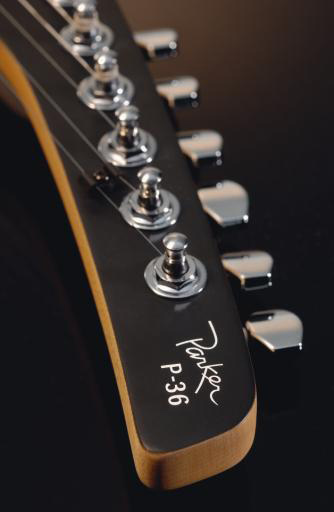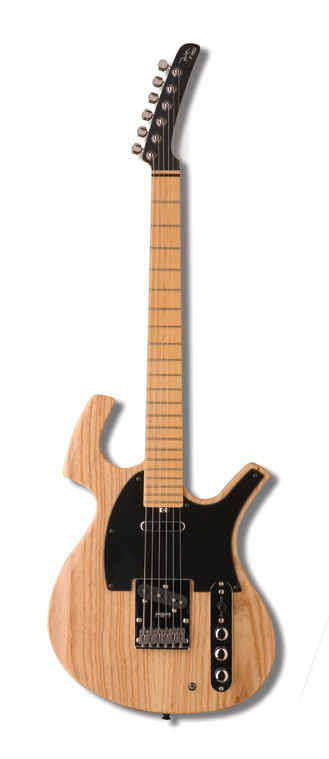MusicRadar Verdict
In terms of sheer functionality there's little to criticise here, but we can't help feeling that the aesthetic will confuse many prospective buyers.
Pros
- +
Good traditional tones and the provision of the Fishman system.
Cons
- -
The look is just too confusing to be pleasing.
MusicRadar's got your back



It would be reasonable to say that the enduring success of the Parker Fly, a revolutionary electric introduced in 1992 that sat fairly and squarely in the ‘space age´ category, will have taken some of the industry by surprise. How could such a thin, lightweight and crazy-looking thing ever capture the hearts and minds of a generation bowled over by the release of Nirvana´s Nevermind opus mere months previously?
Part of the answer must be that guitarists are always after something new and different, and it was the Fly´s diverse nature that caught the attention, certainly visually. Of course, once players actually had a chance to try out a Fly, the sheer quality of the construction, the performance and the tonal aspects, for the most part, sealed the deal there and then.
Parker Guitars has continued to both expand and refine its range over the years, with models like the bolt-on NiteFly, the MIDI Fly, a number of acoustic options and, more recently, the Fly Bass. And what remained constant, alongside the quality, were the wallet-incinerating asking prices.
Even before handing the reins over to US Music Corp, the home of Washburn, Parker had tried producing lower spec´d, and therefore more affordable, offshore guitars - the now deleted P-38 and P-44 spring to mind - but the P-Series arguably represents the biggest stride the company has taken from the tried and trusted track. For a start, the single-cut P-10 and P-20 have a body shape that´s the first new design bearing the Parker legend in 11 years...
P-36
You can have a squint at the P-10 and P-20 on the official Parker website, but we´ve opted to look more closely at what has to be the most controversial and unusual guitar Parker has ever produced - which is certainly saying something. Any hullabaloo surrounding the P-36 is almost solely down to its obvious influence, and you can tick off the Telecaster-influenced features immediately: pickup type and design, bridge and control plate, scratchplate and even the body material all echo Leo Fender's 1952 masterpiece.
Even though the P-36´s body is made from two hefty slabs of select ash in the classic fashion, the guitar still only weighs in at 7lbs. This is down to the familiar degree of Parker bodyshaping, which sees the thickness decrease quite substantially from the body´s lower edge to the upper - from a thickness of 41mm to just under 21mm, in fact. What´s not in question is the actual grade of wood. Judging by the degree of figuring, it is very high indeed: the rear of the body is especially striking.
Want all the hottest music and gear news, reviews, deals, features and more, direct to your inbox? Sign up here.
One of the ways companies can keep RRPs down is to provide their own electrics, and here Parker has forgone custom-wound DiMarzio units in favour of its own Alnico single coils. Of course, no apology is either made or expected for the look of the units employed here, and they are controlled by volume and tone pots, along with a traditional three-way lever.
One of the secrets under the hood of the P-36 is the additional provision of a piezo system, and a good one at that. A Fishman VT Powerbridge includes six independent piezo saddles powered by an active preamp, and a single volume control regulates output. The three-way micro switch sited behind the bridge allows you to mix the piezo in with the magnetic pickups and, thanks to a stereo output, you can either split the signals entirely to different destinations or mix them through the same amp rig. Unlike a full-on, USA-made Fly though, a stereo cable isn´t included with the guitar.
If you´re a fan of the hair-thin frets that are fitted to many a vintage Telecaster, you may be disappointed with the 22 - rather than 21 - medium jumbo options fitted to the P-36´s maple fingerboard. However, for versatility at least, thicker is often better as far as frets are concerned and the finishing here is more than good enough, even though the edges may be a tad too proud for some tastes. The neck itself is fashioned from a single piece of a nicely fiigured maple, although the whole thing is topped off with the classic, blunted Parker headstock - a shape that´s visually somewhat out of place here.
What´s more, it seems to us that the fingerboard has been slightly coloured to give a vintage yellow hue and we feel it´s rather unnecessary. Feel-wise, the guitar doesn´t play much like a classic Tele either, demonstrating a standard width and a pleasantly fat ‘D´-shape.
In use
Having said all of the above, the P-36 demonstrates pretty much the gamut of realistic Telecaster tones. So we reckon that, in a blindfold test with a US Standard, the differences would be hard to discern. The mix of ash with the trademark twang of the bridge pickup is the soundtrack to the fifties and sixties, and Parker has done wonders with the design of its pickups. To our ears the neck single coil has a slightly higher output that we´d expect from a Fender, and so positions two and three on the lever tend to be better balanced with the solo´d bridge pickup tone.
Combining the magnetic array with the Fishman system obviously greatly expands your tonal arsenal, and it works perfectly with the two singles for open strums and smooth finger picked sections. As long as you don´t expect to be able to magically execute styles on the P-36 that you would shy away from on a classic Telecaster, you won´t be let down, and from country to blues and toned-down rock, this is actually something of a winner. One advantage of the classic Parker headstock design is that it allows you to pull off some outrageous, Jerry Donahue-style behind-the-nut bends. The look of this guitar may well repel as many people as it will attract, but be assured that, in the sound stakes at least, it does exactly what you would expect.
The 'never judge a book by its cover' adage has never been more relevant than it is with the P-36, and we have to say that, on its looks alone, we'd probably dismiss it as an abomination to the Lord Our Leo too. Although it certainly holds its own judged solely on its merits, we can't help thinking that most players who want a Telecaster-style instrument are still going to opt for a Fender.
The P-36's price compares favourably with the majority of Far Eastern Fenders, and yes, you have the good Fishman system and we have no quality-related gripes to speak of either, but all in all, you are faced with a difficult buying choice.
MusicRadar is the number 1 website for music makers of all kinds, be they guitarists, drummers, keyboard players, djs or producers...
GEAR: We help musicians find the best gear with top-ranking gear round-ups and high- quality, authoritative reviews by a wide team of highly experienced experts.
TIPS: We also provide tuition, from bite-sized tips to advanced work-outs and guidance from recognised musicians and stars.
STARS: We talk to musicians and stars about their creative processes, and the nuts and bolts of their gear and technique. We give fans an insight into the actual craft of music making that no other music website can.
